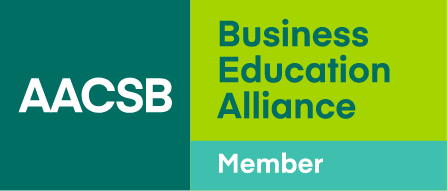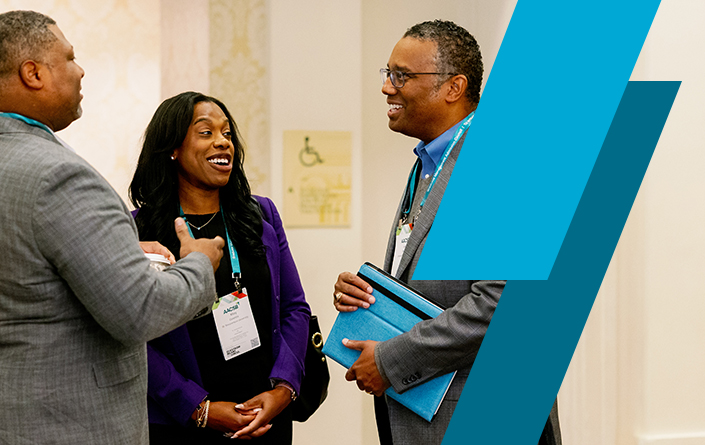Leadership and Governance
Governance Committees and Councils
Purpose
The Articles and Bylaws Committee is responsible for the creation and maintenance of the organization’s bylaws and prepares recommendations for changes in the articles of incorporation and/or bylaws for consideration by the board. The committee is also responsible for preparing recommendations for changes to the Policy Governance Manual for consideration by the board.
Structure
The Articles and Bylaws Committee is composed of up to six, but no less than three, members of the AACSB Board of Directors. The composition of the committee should reflect AACSB’s regional representation as well as its commitment to diversity, equity, inclusion, and belonging. Committee members may serve a maximum of three, one-year terms, which may run consecutively. One member is designated as committee chair by the vice chair-chair elect (who shall preside as board chair during the year for which the appointments are made). In addition, one member is designated as committee vice chair who serves as chair in the absence of the committee chair.Members
Committee Chair
Anne-Marie Croteau, Concordia University
Committee Vice Chair
Delphine Manceau, NEOMA Business School
Committee Members
Helen Brand, Association of Chartered Certified Accountants
Susan Fournier, Boston University
Xiongwen Lu, Fudan University
Staff Liaison
Neil Bosland, Executive Vice President and Chief Operating and Financial Officer, AACSB International
Purpose
The Audit Committee provides oversight of AACSB's financial reporting process and the selection of the independent audit firm. The committee oversees the annual audit of the financial records; receives the results of the independent audit; and recommends to the board and staff such changes in records, internal controls, and procedures, as it deems necessary.Structure
The Audit Committee is composed of up to six, but no less than four members, including the secretary-treasurer and the chair of the Finance and Investment Committee as ex officio members. The remaining positions are members of the AACSB Board of Directors appointed by the vice chair-chair elect (who shall preside as board chair during the year for which the appointments are made). The composition of the committee should reflect AACSB’s regional representation as well as its commitment to diversity, equity, inclusion, and belonging. Committee members may serve a maximum of three, one-year terms, which may run consecutively. One committee member is designated as committee chair by the vice chair-chair elect (who shall preside as board chair during the year for which the appointments are made). In addition, one member is designated as committee vice chair who serves as chair in the absence of the committee chair.Members
Committee Chair
Frank Buckless, North Carolina State University
Committee Vice Chair
Kathleen A. Farrell, University of Nebraska-Lincoln
Committee Members
Isabelle Chaquiriand, Universidad Católica del Uruguay
Mariëlle Heijltjes, Maastricht University
Margaret Williams, Texas Tech University
Ex Officio Member (Finance and Investment Committee Chair)
Peter Møllgaard, Copenhagen Business School
Ex Officio Member (Board Secretary-Treasurer)
Lee Newman, IE Business School
Staff Liaison
Damion Dam, Director of Financial and Accounting Strategy, AACSB International
Purpose
The Executive Committee advises the chair and president and CEO on matters pertaining to the board’s business and staff operations. Between meetings of the board, the Executive Committee may act on behalf of the entire board if the full board’s participation is not feasible or warranted. The committee has oversight of executive compensation and benefits programs offered exclusively to the executive team, works with the president and CEO to develop annual strategic goals for the president and CEO, reviews and evaluates the achievement of these goals, and sets the compensation of the president and CEO. The committee also has oversight of the president and CEO and executive team to ensure the alignment of organizational goals and compensation, including incentive programs, of the president and CEO and executive team.
Structure
The Executive Committee is composed of the board chair, board vice chair-chair elect, immediate past chair, board secretary-treasurer, the president and CEO, and up to three additional directors appointed by the vice chair-chair elect (who shall preside as board chair during the year for which the appointments are made). In the event the immediate past board chair is unable to serve, the person designated by the current board chair and endorsed by the board of directors will serve.
The board chair serves as executive committee chair. Committee members also serving as board officers may serve a maximum of three, one-year terms, which may run consecutively. Each of the additional directors serve a two-year term on a staggered basis. The composition of the committee should reflect AACSB’s regional representation as well as its commitment to diversity, equity, inclusion, and belonging.
Members
Committee Chair
Joyce A. Strawser, Seaton Hall University (Board Chair)
Committee Vice Chair
Ian O. Williamson, University of California, Irvine (Board Vice Chair-Chair Elect)
Board Immediate Past Chair
Sherif H. Kamel, The American University in Cairo
Board Secretary-Treasurer
Lee Newman, IE Business School
Ex Officio Member (President and CEO)
Lily Bi, AACSB International
Purpose
The Finance and Investment Committee provides oversight of AACSB’s financial condition and asset safeguarding. The Finance and Investment Committee monitors the financial strategies of AACSB, approves the selection of the investment consulting and advisory firm, and oversees the AACSB investment portfolio.
Structure
The Finance and Investment Committee is composed of up to eight, but no less than six, members of the board of directors. The composition of the committee should reflect AACSB’s regional representation as well as its commitment to diversity, equity, inclusion, and belonging. In addition to the committee members, the secretary-treasurer and the chair of the Audit Committee serve as ex officio members of the Committee. Committee members may serve a maximum of three, one-year terms, which may run consecutively. One committee member is designated as committee chair by the vice chair-chair elect (who shall preside as board chair during the year for which the appointments are made). In addition, one member is designated as committee vice chair who serves as chair in the absence of the committee chair.
Members
Committee Chair
Peter Møllgaard, Copenhagen Business School
Committee Vice Chair
Lailani Alcantara, Ritsumeikan Asia Pacific University
Committee Members
Andrew Karolyi, Cornell SC Johnson College of Business, Cornell University
Rowena Ortiz-Walters, St. Mary’s University
Ex Officio Member (Audit Committee Chair)
Frank Buckless, North Carolina State University
Ex Officio Member (Board Secretary-Treasurer)
Lee Newman, IE Business School
Staff Liaison
Neil Bosland, Executive Vice President and Chief Operating and Financial Officer, AACSB International
Purpose
The Nominating Committee is responsible for reviewing nominees solicited from its member organizations and selecting the slate of candidates for all open AACSB officer and director positions being presented for election in January of each year.
Structure
The Nominating Committee is composed of the board chair (who serves as Nominating Committee vice chair); vice chair-chair elect; immediate past chair (who serves as Nominating Committee chair), or in the event the immediate past chair is unable to serve, the person designated by the current board chair and endorsed by the board of directors; and up to six other members from the membership at large, appointed by the vice chair-chair elect. The composition of the committee should reflect AACSB's regional representation as well as it’s commitment to diversity, equity, inclusion, and belonging.
Members
Committee Chair (Immediate Past Board Chair)
Sherif Kamel, The American University in Cairo
Committee Vice Chair (Current Board Chair)
Joyce A. Strawser, Seaton Hall University
Committee Members
Thami Ghorfi, ESCA Ecole de Management
Barbara Ritter, The University of Toledo
Ian Williamson, University of California, Irvine (Board Vice Chair-Chair Elect)
Staff Liaison
Neil Bosland, Executive Vice President and Chief Operating and Financial Officer, AACSB International
Purpose
The Innovation Committee is charged with helping to empower business education providers and their partners to move deeply, strategically, and successfully in pursuit of new opportunities that positively impact business and society. The Innovation Committee explores emerging innovations and effective practices, helps to incubate ideas and a vision for business education, and guides AACSB efforts to develop reports and other content aimed at helping business education providers and their stakeholders to understand the related challenges and opportunities. The committee evaluates issues and challenges and makes recommendations to the board on AACSB policies, plans, and tactics for addressing identified challenges and opportunities. The committee may commission independent research within the annual operating and capital budgets approved by the board.
Structure
The Innovation Committee is composed of at least seven members with representation from accredited and non-accredited educational organizations, and business organizations. Appointments should ensure that the committee has the appropriate knowledge and skill set to fulfill its responsibilities. A majority of the committee members must be current members of the AACSB board. The committee is chaired by the board vice chair-chair elect, and members are appointed annually. The current board chair serves as vice chair of the committee and serves as chair in the absence of the committee chair. The composition of the committee should reflect AACSB’s regional representation as well as its commitment to diversity, equity, inclusion, and belonging, and members normally serve a maximum of three, one-year terms, which may run consecutively.
Members
Committee Chair
Ian O. Williamson, University of California, Irvine
Committee Vice Chair
Joyce A. Strawser, Seton Hall University
Committee Members
Lailani Laynesa Alcantara, Ritsumeikan Asia Pacific University
Paul C. Almeida, Georgetown University
Helen Brand, Association of Chartered Certified Accountants
Frank Buckless, North Carolina State University
Isabelle Chaquiriand, Universidad Católica del Uruguay
Anne-Marie Croteau, Concordia University
Kathleen A. Farrell, University of Nebraska-Lincoln
Susan Fournier, Boston University
Thami Ghorfi, ESCA Ecole de Management
Mariëlle G. Heijltjes, Maastricht University
Sherif H. Kamel, The American University in Cairo
Andrew Karolyi, Cornell University
Xiongwen Lu, Fudan University
Delphine Manceau, NEOMA Business School
Sharon Matusik, The University of Michigan
Michael Mazzeo, Washington University in St. Louis
Peter Møllgaard, Copenhagen Business School
Lee Newman, IE Business School
Lisa Ordóñez, University of California, San Diego
Rowena Ortiz-Walters, St. Mary’s University
Paul A. Pavlou, University of Miami
Corey C. Phelps, The Pennsylvania State University
Barbara Ritter, The University of Toledo
Paul H. Schwager, College of Charleston
Derek W. Thomas, KPMG
Francisco Veloso, INSEAD
Margaret L. Williams, Texas Tech University
Ex Officio Member
Lily Bi, AACSB International
Staff Liaison
Hanna McLeod, Director of Thought Leadership, AACSB International
Purpose
The purpose of the Asia Pacific Advisory Council (APAC) is to advise the AACSB board of directors and staff on key issues and challenges, assist in setting priorities related to business education and AACSB's mission, and enhance AACSB’s activities and engagement in the Asia Pacific context.
Structure
The APAC is composed of a chair and up to 11 members appointed by the board vice chair-chair elect. Of the 12 members, at least five must be deans or those holding similar roles representing AACSB-accredited organizations in the Asia Pacific region. The remainder may be deans or those holding senior leadership roles representing Asia Pacific institutions that, at the time of appointment, are either member organizations, member organizations formally accepted into the AACSB initial accreditation process, or representatives from business organizations or business practice. The council composition should reflect AACSB’s commitment to diversity and inclusion.
Chair
Maryam Omari, Edith Cowan University
Members
Aurik Gustomo, Institut Teknologi Bandung – School of Business Management
Himadri Das, International Management Institute, Delhi
Hyun Jeong Kim, Inha University
Khongphu Nimanandh, Chiang Mai University Business School (CMUBS), Chiang Mai University
Makiko Sugiyama, Nikkei Business Lab Asia
Maree Thyne, University of Otago
Mohan Lakhamraju, Great Learning
Qian Shi, Tongji University
Roberto N. Galang, John Gokongwei School of Management, Ateneo de Manila University
Shing-yang Hu, National Taiwan University
Yusniza Kamarulzaman, Universiti Malaya
AACSB Staff Liaisons
Geoff Perry, Executive Vice President and Chief Membership Officer, Asia Pacific & Americas
Angelina R. Chandra, Senior Office Administrator
Purpose
The purpose of the Business Influencer Council (BIC) (formerly Business Practice Council) is to serve as an ongoing partnership between the business community and business schools. Council members are invited to bring their perspectives, expertise, and insights to discussions as the BIC improves business education worldwide and engages with the AACSB network in matters of mutual advantage.
Structure
The BIC is composed of two co-chairs, business school faculty, and members of the business community, with the public, private, and social sectors represented.
Members
Council Co-Chairs
Holly Raider, School of Business, Quinnipiac University
Council Members
Sulin Ba, Driehaus College of Business and Kellstadt Graduate School of Business, DePaul University
Camelia Ilie Cardoza, INCAE Business School
Mark Cousino, Kyndryl
Jason Crimson, GBS Hub Consulting
Ellen Desmarais, Harvard Business Publishing (HBP)
Simon Hayward, Alliance Manchester Business School, University of Manchester
Bill Imada, IW Group
Helen Li, The Bank of East Asia Limited
Jim Link, SHRM
Julie Peters, PwC
Jasmina Selimovic, Central Bank of Bosnia and Herzegovina
Jennifer Woods, Future Business Leaders of America, Inc (FBLA)
Staff Liaison
Greg Van Choyke, AACSB International
Purpose
The purpose of the European Advisory Council (EAC) is to advise the AACSB Board of Directors and staff on key issues and challenges, assist in setting priorities related to business education and AACSB’s mission, and enhance AACSB’s activities and engagement in the European context.
Structure
The EAC is composed of a chair and up to 11 members to be appointed by the board vice chair-chair elect. Of the 12 members, at least five are deans or those holding similar roles representing AACSB-accredited organizations located in Europe. The remainder may be deans or those holding senior leadership roles representing European organizations that, at the time of appointment, are either member organizations, member organizations formally accepted into the AACSB initial accreditation process, or representatives from business organizations or business practice. The composition of the council should reflect AACSB’s commitment to diversity and inclusion.
Members
Council Chair
Hanna-Leena Pesonen, University of Jyväskylä, Finland
Council Members
Mark Brewer, University of St. Andrews, United Kingdom
Sofronis Clerides, University of Cyprus, Cyprus
Maria Cortinhal, ISCTE Business School, University Institute of Lisbon, Portugal
Ralf Dillerup, Heilbronn University Graduate School, Germany
Beáta Fehérvölgyi, Faculty of Business and Economics, University of Pannonia, Hungary
Christophe Germain, SKEMA Business School, France
Barbara Jankowska, Poznan University of Economics and Business, Poland
M.N. Ravishankar, Queen’s University Belfast, United Kingdom
Karen Spens, BI Norwegian Business School, Norway
Valentin Toader, Babeș-Bolyai University Cluj-Napoca, Romania
Corporate Representatives
John Knott, PeopleCert, United Kingdom
Vicky Lester, The Case Centre, United Kingdom
Staff Liaisons
Audrey Milton, Regional Head, Europe, AACSB International
Eileen McAuliffe, EVP, Chief Thought Leadership Officer & EMEA, AACSB International
Purpose
The purpose of the Latin American and Caribbean Advisory Council (LAAC) is to advise the AACSB board of directors and staff on key issues and challenges, assist in setting priorities related to business education and AACSB’s mission, and enhance AACSB’s activities and engagement in the Latin American and Caribbean context.
Structure
The LAAC is composed of a chair and up to 11 members to be appointed by the board vice chair-chair elect. Of the 12 members, at least five are deans or those holding similar roles representing AACSB-accredited institutions located in Latin America or the Caribbean. The remainder may be deans or those holding senior leadership roles representing Latin American or Caribbean institutions that, at the time of appointment, are either member organizations, member organizations formally accepted into the AACSB initial accreditation process, or representatives from business organizations or business practice. The council composition should reflect AACSB’s commitment to diversity and inclusion.
Members
Chair
Isabelle Chaquiriand, Universidad Católica del Uruguay
Members
Horacio Arredondo, EGADE Business School
Helmuth Chávez, Universidad Francisco Marroquín
Andrea Catalina Martinez-Lozada, Universidad Autónoma De Bucaramanga
Patrícia Fagundes, Universidade do Vale do Rio dos Sinos - UNISINOS
Matías Lira, Universidad del Desarollo
Monica Lopez Sieben, Escuela de Graduados en Administración en CETYS
Melani Machinea, Universidad Torcuato Di Tella
Julissa Pichardo, Pontificia Universidad Católica Madre y Maestra
Edison Simoni, Fundação Escola de Comércio Álvares Penteado (FECAP)
Juan Carlos Sosa, Universidad Ana G. Mendez
Miriam Stolses Mazo, Pontifícia Universidade Católica do Paraná
AACSB Staff Liaisons
Tim Mescon, Vice President, Americas Growth and Engagement
Patty Edmondson, Member Engagement Manager
Purpose
The purpose of the Middle East and Africa Advisory Council (MEAAC) is to advise the AACSB board of directors and staff on key issues and challenges, assist in setting priorities related to business education and AACSB’s mission, and enhance AACSB’s activities and engagement in the MEA context.
Structure
MEAAC is composed of a chair and up to 11 members to be appointed by the board vice chair-chair elect. Of the 12 members, at least five are deans or those holding similar roles representing AACSB-accredited organizations in the Middle East or Africa. The remainder may be deans or those holding senior leadership roles representing Middle Eastern or African institutions that, at the time of appointment, are either member organizations, member organizations formally accepted into the AACSB initial accreditation process, or representatives from business organizations or business practice. The council composition should reflect AACSB’s commitment to diversity and inclusion.
Members
Chair
Karim Seghir, Ajman University
Council Members
Tameem Al Bassam, King Abdulaziz University
Abdulla Yousif Al-Hawaj, Ahlia University
Lakshmi Goel, Al Akhawayn University in Ifrane
Washika Haak-Saheem, University of Dubai
Khaled Hegazy, New Giza University
Ra'fat Jallad, An-Najah National University
Joanne Powell, QED: The Accreditation Experts
Yusuf Sidani, American University of Beirut
Rana Sobh, Qatar University
Leila Triki, SMU–South Mediterranean University
Christine van den Toorn, Baghdad Foundation for Business Management
Staff Liaison
Ihsan Zakri, Vice President, EMEA Growth and Engagement, AACSB International
Eileen McAuliffe, Executive Vice President, Chief Thought Leadership Officer, and EMEA, AACSB International






